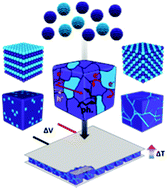当前位置:
X-MOL 学术
›
Chem. Soc. Rev.
›
论文详情
Our official English website, www.x-mol.net, welcomes your feedback! (Note: you will need to create a separate account there.)
Bottom-up engineering of thermoelectric nanomaterials and devices from solution-processed nanoparticle building blocks
Chemical Society Reviews ( IF 46.2 ) Pub Date : 2017-05-04 00:00:00 , DOI: 10.1039/c6cs00567e Silvia Ortega 1, 2, 3 , Maria Ibáñez 4, 5, 6, 7, 8 , Yu Liu 1, 2, 3 , Yu Zhang 1, 2, 3 , Maksym V. Kovalenko 4, 5, 6, 7, 8 , Doris Cadavid 1, 2, 3 , Andreu Cabot 1, 2, 3, 9, 10
Chemical Society Reviews ( IF 46.2 ) Pub Date : 2017-05-04 00:00:00 , DOI: 10.1039/c6cs00567e Silvia Ortega 1, 2, 3 , Maria Ibáñez 4, 5, 6, 7, 8 , Yu Liu 1, 2, 3 , Yu Zhang 1, 2, 3 , Maksym V. Kovalenko 4, 5, 6, 7, 8 , Doris Cadavid 1, 2, 3 , Andreu Cabot 1, 2, 3, 9, 10
Affiliation

|
The conversion of thermal energy to electricity and vice versa by means of solid state thermoelectric devices is extremely appealing. However, its cost-effectiveness is seriously hampered by the relatively high production cost and low efficiency of current thermoelectric materials and devices. To overcome present challenges and enable a successful deployment of thermoelectric systems in their wide application range, materials with significantly improved performance need to be developed. Nanostructuration can help in several ways to reach the very particular group of properties required to achieve high thermoelectric performances. Nanodomains inserted within a crystalline matrix can provide large charge carrier concentrations without strongly influencing their mobility, thus allowing to reach very high electrical conductivities. Nanostructured materials contain numerous grain boundaries that efficiently scatter mid- and long-wavelength phonons thus reducing the thermal conductivity. Furthermore, nanocrystalline domains can enhance the Seebeck coefficient by modifying the density of states and/or providing type- and energy-dependent charge carrier scattering. All these advantages can only be reached when engineering a complex type of material, nanocomposites, with exquisite control over structural and chemical parameters at multiple length scales. Since current conventional nanomaterial production technologies lack such level of control, alternative strategies need to be developed and adjusted to the specifics of the field. A particularly suitable approach to produce nanocomposites with unique level of control over their structural and compositional parameters is their bottom-up engineering from solution-processed nanoparticles. In this work, we review the state-of-the-art of this technology applied to the thermoelectric field, including the synthesis of nanoparticles of suitable materials with precisely engineered composition and surface chemistry, their combination and consolidation into nanostructured materials, the strategies to electronically dope such materials and the attempts to fabricate thermoelectric devices using nanoparticle-based nanopowders and inks.
中文翻译:

从溶液处理的纳米颗粒构建块开始的热电纳米材料和设备的自下而上工程
将热能转化为电能,反之亦然借助固态热电装置极具吸引力。然而,由于目前的热电材料和装置的相对较高的生产成本和较低的效率,其成本效益严重受到阻碍。为了克服当前的挑战并使热电系统能够在广泛的应用范围内成功部署,需要开发性能显着提高的材料。纳米结构可以以多种方式帮助达到高热电性能所需的非常特殊的一组性能。插入晶体基质中的纳米域可以提供较大的电荷载流子浓度,而不会强烈影响其迁移率,因此可以实现很高的电导率。纳米结构材料包含许多晶界,这些晶界有效地散射了中波长和长波长的声子,从而降低了热导率。此外,纳米晶域可以通过改变态密度和/或提供依赖于类型和能量的载流子散射来提高塞贝克系数。所有这些优势只有在设计复杂类型的材料(纳米复合材料)并在多个长度尺度上对结构和化学参数进行精确控制时才能实现。由于当前的常规纳米材料生产技术缺乏这种控制水平,因此需要开发替代策略并针对该领域的具体情况进行调整。生产对其结构和组成参数具有独特控制水平的纳米复合材料的一种特别合适的方法是从溶液加工的纳米颗粒进行自下而上的工程设计。在这项工作中,我们回顾了应用于热电领域的最新技术,包括合成具有精确设计的成分和表面化学性质的合适材料的纳米颗粒,将它们结合并固结成纳米结构材料,电子掺杂此类材料,并尝试使用基于纳米颗粒的纳米粉和油墨来制造热电设备。
更新日期:2017-05-05
中文翻译:

从溶液处理的纳米颗粒构建块开始的热电纳米材料和设备的自下而上工程
将热能转化为电能,反之亦然借助固态热电装置极具吸引力。然而,由于目前的热电材料和装置的相对较高的生产成本和较低的效率,其成本效益严重受到阻碍。为了克服当前的挑战并使热电系统能够在广泛的应用范围内成功部署,需要开发性能显着提高的材料。纳米结构可以以多种方式帮助达到高热电性能所需的非常特殊的一组性能。插入晶体基质中的纳米域可以提供较大的电荷载流子浓度,而不会强烈影响其迁移率,因此可以实现很高的电导率。纳米结构材料包含许多晶界,这些晶界有效地散射了中波长和长波长的声子,从而降低了热导率。此外,纳米晶域可以通过改变态密度和/或提供依赖于类型和能量的载流子散射来提高塞贝克系数。所有这些优势只有在设计复杂类型的材料(纳米复合材料)并在多个长度尺度上对结构和化学参数进行精确控制时才能实现。由于当前的常规纳米材料生产技术缺乏这种控制水平,因此需要开发替代策略并针对该领域的具体情况进行调整。生产对其结构和组成参数具有独特控制水平的纳米复合材料的一种特别合适的方法是从溶液加工的纳米颗粒进行自下而上的工程设计。在这项工作中,我们回顾了应用于热电领域的最新技术,包括合成具有精确设计的成分和表面化学性质的合适材料的纳米颗粒,将它们结合并固结成纳米结构材料,电子掺杂此类材料,并尝试使用基于纳米颗粒的纳米粉和油墨来制造热电设备。



























 京公网安备 11010802027423号
京公网安备 11010802027423号